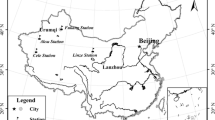Abstract
Resource-based water-saving potential has been recognized as the reduction of evapotranspiration and water loss of inefficient irrigation systems. In this paper, an improved evapotranspiration control model is applied to calculate resource-based water-saving potential, considering the influences of effective rainfall (uncontrolled evapotranspiration) and irrigated water (controlled evapotranspiration). Farmland in Baiyangdian Watershed, a highly productive area in northern China, is analyzed to determine the water-saving potential of irrigation processes. The water-saving potential was zero, 163.90 × 106 m3, and 318.24 × 106 m3 in wet, normal, and dry years, respectively, and was greater in years with less rainfall. Under the combined effect of rainfall, crop water consumption, and crop water requirements, the water-saving potential showed obvious temporal and spatial variations. July and August comprised almost 98.6% of the annual potential. In the northeast and southwest corner of the study area, potential approached zero. The potential was 1.53 times greater in the north-central than in the south-central area. The model can furnish the appropriate timing and region to water managers for implementing water-saving strategies.
Similar content being viewed by others
References
Akita T, Sakai K, Iwabuchi Y, Hoshino Y, Ye X J (2008). Spatial autocorrelation in masting phenomena of quercus serrate detected by multi-spectral imaging. Ecol modell, 215(1–3): 217–224
Blanke A, Rozelle S, Lohmar B, Wang J X, Huang J K (2007). Water saving technology and saving water in China. Agric Water Manage, 87(2): 139–150
Cai Y P, Huang G H, Tan Q (2009). An inexact optimization model for regional energy systems planning in the mixed stochastic and fuzzy environment. Int J Energy Res, 33(5): 443–468
Du T S, Kang S Z, Sun J S, Zhang X Y, Zhang J H (2010). An improved water use efficiency of cereals under temporal and spatial deficit irrigation in North China. Agric Water Manage, 97(1): 66–74
Dunn S M, Stalham M, Chalmers N, Crabtree B (2003). Adjusting irrigation abstraction to minimise the impact on stream flow in the East of Scotland. J Environ Manage, 68(1): 95–107
Gao Q Z, Du H L, Zu R P (2002). The balance between supply and demand of water resources and the water-saving potential for agricultural in the Hexi corridor. Chin Geogr Sci, 12(1): 23–29
Horst M G, Shamutalov S S, Pereira L S, Goncalves J M (2005). Field assessment of the water saving potential with furrow irrigation in Fergana, Aral Sea basin. Agric Water Manage, 77(1–3): 210–231
Karimov A, Molden D, Khamzina T, Platonov A, Ivanov Y (2012). A water accounting procedure to determine the water savings potential of the Fergana Valley. Agric Water Manage, 108: 61–72
Lankford B (2012). Fictions, fractions, factorials and fractures: on the framing of irrigation efficiency. Agric Water Manage, 108: 27–38
Li H J, Zheng L, Lei Y P, Li C Q, Liu Z J, Zhang SW (2008). Estimation of water consumption and crop water productivity of winter wheat in North China Plain using remote sensing technology. Agric Water Manage, 95(11): 1271–1278
Liu J H, Qin D Y, Wang MN, Sang X F, Lv J Y, Zhang RM (2009). The basic theory and calculated method for the regional objective ET: case study. Science in China Series E: Technological Sciences, 39(2): 318–323 (in Chinese)
Liu S, Butler D, Menmon F A, Makropoulos C, Avery L, Jefferson B (2010). Impacts of residence dime during storage on potential of water saving for grey water recycling system.Water Res, 44(1): 267–277
Mo X, Liu S, Lin Z, Xu Y, Xiang Y, McVicar T R (2005). Prediction of crop yield, water consumption and water use efficiency with a SVAT-crop growth model using remotely sensed data on the North China Plain. Ecol Modell, 183(2–3): 301–322
Pei Y S, Zhang J P, Zhao Y (2007). Water saving potential in irrigation area of Ningxia Autonomous Region. J Hydraul Eng, 38(2): 239–243
Peng Z G, Liu Y, Xu D, Wang L (2009). Application of RS and GIS technique for water-saving potential estimation of regional crops. Transactions of the Chinese Society of Agricultural Engineering, 25(7): 8–12 (in Chinese)
Shen Z L, Wang L, Yu F L (2000). New Concept of Water Saving: Study and Application of Real Water Saving. Beijing: China Water Power Press (in Chinese)
Wu B F, Xiong J, Yan N N, Yang L D, Du X (2008). ET Watch for monitoring regional evapotranspitation with remote sensing. Advances in Water Science, 19(5): 671–679 (in Chinese)
Wu B F, Yan N N, Xiong J, Bastiaanssen W G M, Zhu W W, Stein A (2012). Validation of ETWatch using field measurements at diverse landscapes: a case study in Hai Basin of China. J Hydrol (Amst), 436-437: 67–80
Zhang H, Wang X, You M, Liu C (1999). Water-yield relations and water-use efficiency of winter wheat in North China Plain. Irrig Sci, 19(1): 37–45
Author information
Authors and Affiliations
Corresponding author
Rights and permissions
About this article
Cite this article
Pang, A., Li, C., Sun, T. et al. An improved ET control method to determine the water-saving potential for farmland in Baiyangdian Watershed, China. Front. Earth Sci. 7, 151–158 (2013). https://doi.org/10.1007/s11707-013-0351-5
Received:
Accepted:
Published:
Issue Date:
DOI: https://doi.org/10.1007/s11707-013-0351-5




